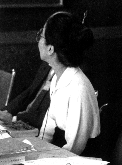A Taeko Brooks
University of Massachusetts at Amherst
War and the State in the Lw-shr Chun/Chyou
Panel: Converging Toward Empire
AAS Convention, New York City, 27 March 2003
Abstract The rather extreme statements on war made in LSCC 7-9 have often been noted. This position, however, does not characterize the whole text. I find that a major discontinuity in the text's idea of war as an instrument of state policy exists between the Ji (LSCC 1-12) and the balance of the text, and that this discontinuity is most readily accounted for by assuming a considerable lapse of time between the two.
1. The Ji Section (LSCC 1-12) is the one to which the postface and its composition date of c0241 properly apply. These chapters, and especially LSCC 7-9, emphasize the primacy of weapons, and exalt the military over the civil. They take the view that war is the origin and basis of government. War and weapons are justified in moral terms, and the possibility of abolishing weapons is denied. The total identification between war and the state in these chapters is intelligible in a state which is making an all-out effort to unify the world by the use of military force, as Chin was doing before 0221.
2. The Lan Section (LSCC 13-20), by contrast, separates war and morality. It recognizes virtuous government as itself a deterrent to attack. It considers war as a cyclical phenomenon, and admits the possibility of abolishing weapons. It sees society as founded on mutuality and social organization, and it exalts the the civil over the military. Such military operations as it does envision are essentially for the preservation of an existing civil order. It denigrates military prowess, and rejects the Sundzian tactics of deception as shortsighted. This theoretical position does not suggest a nation at war, but a nation redefining itself in terms of peace. This was the situation of Chin in 0221. The policy of Chin at that time was not in promoting war, but in eliminating the possibility of further war.
3. The Lun Section (LSCC 21-26) is generally compatible with the Lan, but develops that position further in some respects. It does not discuss the creation of the state, but holds that peace rather than war is the proper basis of the state. It sees the military as necessary to the state's survival, but in tactical terms, it prefers to win without actual fighting. It emphasizes that kingdoms may be won by force, but have to be held by nonmilitary means. The general position is compatible with that of the Lan, but with a further distancing from the actualities of war, and with a more detailed sense of the difficulty of civil reconstruction following war. This suggests a date still within the Chin dynasty but somewhat later than the Lan.
In sum, the theories of war expressed in the three sections of LSDC do not suggest alternate views appropriate to the postface year 0241, but rather successive views which respond in turn to (1) that period, (2) the immediate post-Unification period, and (3) a time well within the Chin dynasty.
All lectures and abstracts posted on this site are Copyright © by their authors.
28 Sept 2002 / Contact The Project / Conferences Page
